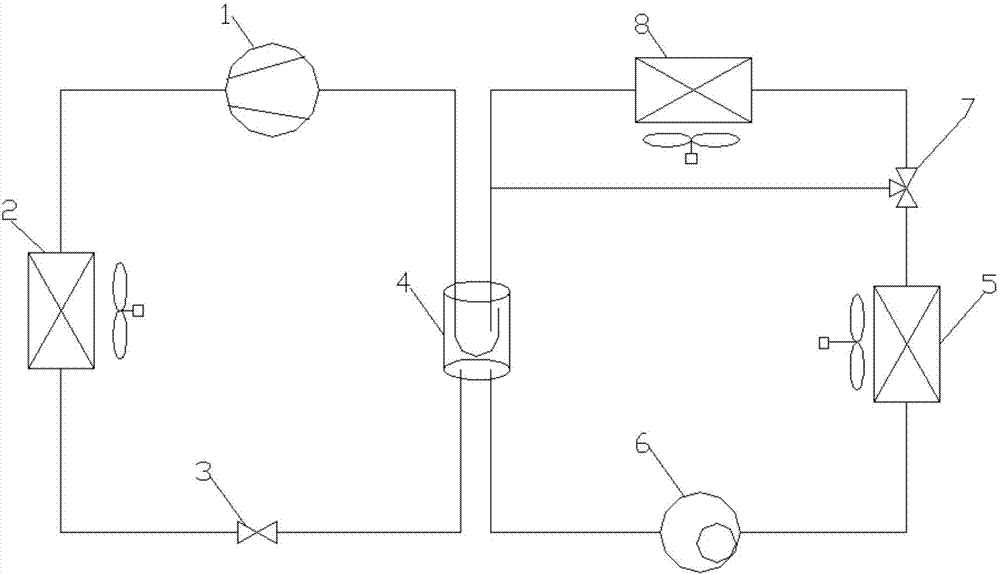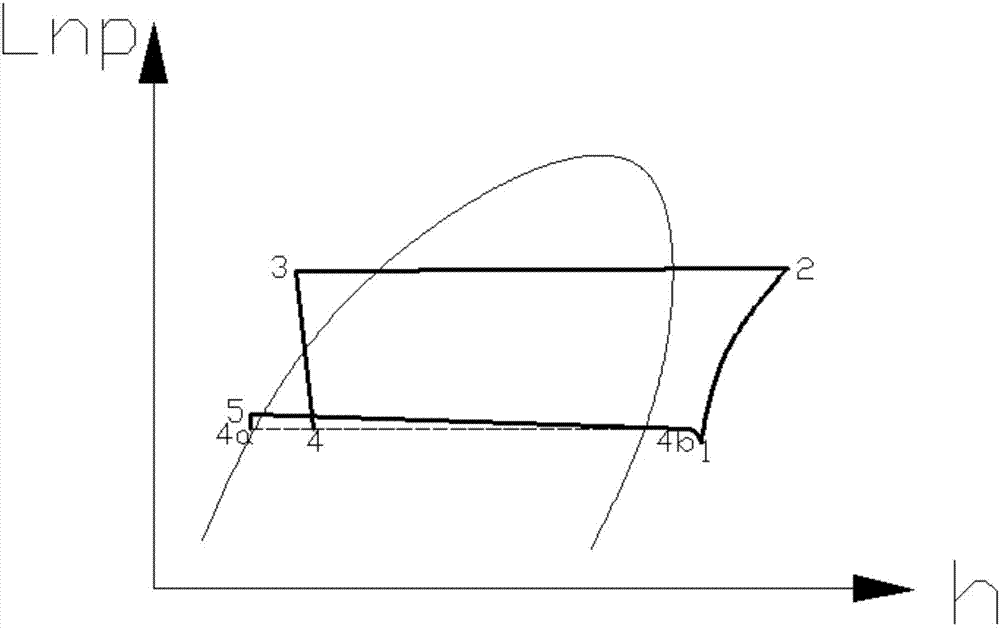A control method for a composite computer room air conditioning system
A technology of computer room air conditioning and control method, which is applied in the directions of refrigerators, compressors, refrigeration components, etc., can solve the problems of the upper limit temperature and the unfavorable utilization of outdoor low-temperature air, etc., to avoid low heat transfer efficiency, stable liquid supply, and high thermal efficiency. Effect
- Summary
- Abstract
- Description
- Claims
- Application Information
AI Technical Summary
Problems solved by technology
Method used
Image
Examples
Embodiment 1
[0072] In summer, when the outdoor ambient temperature T is 33°C and is higher than the preset temperature Tb and is 25°C, the operating mode of the air conditioner unit is determined to be the refrigeration cycle, and the temperature control device controls the three-way valve 7 to switch to the refrigeration cycle. If machine 1 is turned on and the heat exchange fan runs at full speed, the circulation path of the refrigerant in the compound computer room air conditioning system is: from compressor 1 to refrigeration condenser 2, to throttling device 3 and low-pressure liquid receiver 4, and then to The low-pressure accumulator 4 goes to the compressor 1 and the refrigerant pump 6, and the refrigerant goes from the refrigerant pump 6 to the evaporator 5, and then passes through the three-way valve 7, the low-pressure accumulator 4 and the refrigerant pump 6; due to the outdoor environment The high temperature T makes the heat load of the composite computer room air-conditionin...
Embodiment 2
[0085] In spring or autumn, when the outdoor ambient temperature T is 22°C, 25°C lower than the preset temperature Tb, and 15°C higher than the set temperature Ta, the operating mode of the air conditioner unit is determined to be compound cycle. , the temperature control device controls the three-way valve 7 to switch to the composite cycle. At this time, the compressor 1 is turned on, and the heat exchange fan runs at full speed, so the circulation path of the refrigerant in the composite computer room air conditioning system is: from the compressor 1 to the refrigeration condenser 2. Then to the throttling device 3 and the low-pressure accumulator 4, then from the low-pressure accumulator 4 to the compressor 1 and the refrigerant pump 6, and then the refrigerant goes from the refrigerant pump 6 to the evaporator 5, and then passes through the three-way Valve 7, heat pipe condenser 8, low-pressure accumulator 4 and refrigerant pump 6; since the outdoor ambient temperature T i...
Embodiment 3
[0098] In winter, when the outdoor ambient temperature T is 8°C and is 15°C lower than the set temperature Ta, the operating mode of the air conditioner unit is determined to be heat pipe circulation, and the temperature control device controls the three-way valve 7 to switch to heat pipe circulation , at this time, the compressor 1 is turned off, and the heat exchange fan is running at full speed or with speed regulation, then the circulation path of the refrigerant in the composite computer room air conditioning system is: from the refrigerant pump 6 to the evaporator 5, and then through the three-way valve 7 in turn , heat pipe condenser 8, low-pressure liquid receiver 4 and refrigerant pump 6; since the outdoor ambient temperature T is much lower than the temperature of the machine room, and can provide sufficient cooling capacity to the machine room to maintain a suitable temperature in the machine room, the third type In the control mode, the gaseous or gas-liquid mixed r...
PUM
 Login to View More
Login to View More Abstract
Description
Claims
Application Information
 Login to View More
Login to View More - R&D
- Intellectual Property
- Life Sciences
- Materials
- Tech Scout
- Unparalleled Data Quality
- Higher Quality Content
- 60% Fewer Hallucinations
Browse by: Latest US Patents, China's latest patents, Technical Efficacy Thesaurus, Application Domain, Technology Topic, Popular Technical Reports.
© 2025 PatSnap. All rights reserved.Legal|Privacy policy|Modern Slavery Act Transparency Statement|Sitemap|About US| Contact US: help@patsnap.com



